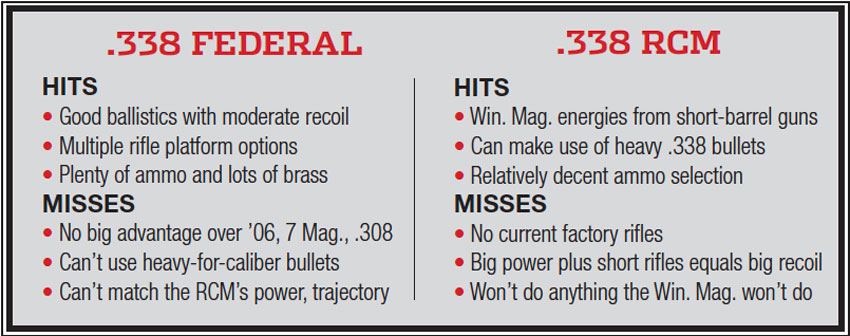
Federal Premium offered its first namesake cartridge to the world in 2006. Dubbed the .338 Federal, this new compact cartridge was generated by simply necking-up the much-loved .308 Win. to accept .338 bullets. Wildcatters had been doing the same thing for years—most notably outdoor writer Roy Smith—but it was Federal that legitimized the round and filled the last branch on the .308 family tree.
Two years later it was Ruger’s turn. The company already had a parent cartridge, the .375 Ruger, that provided plenty of case capacity for the creation of a new, short .338 round. This round became known as the .338 Ruger Compact Magnum, or .338 RCM, and it promised .338 Win. Mag.-like performance from a more compact, efficient cartridge. Ruger built the rifles, and Hornady supplied the ammunition.
Both the .338 Federal and .338 RCM work well in short-barreled, compact, lightweight hunting rifles, but despite their similar profiles and bullet diameters, these are two very different cartridges in terms of performance. The .338 Federal pushes a 200-grain Trophy Bond Tip bullet at about 2,630 fps from the muzzle. By contrast, the .338 RCM drives a 200-grain Hornady SST bullet down the barrel at 2,950 fps.
The .338 Federal’s 200-grain TBT drops 9.2 inches at 300 yards when zeroed at 200 yards whereas Hornady’s 200-grain SST load in the .338 RCM drops just 6.9 inches at that same range with the same zero. As ranges increase from there, so does the trajectory gap.
As you might expect, the RCM has a sizable advantage in terms of energy, too. The .338 Federal generates 3,071 ft.-lbs. of muzzle energy while the .338 RCM is creating 3,850 ft.-lbs. at the muzzle. At 300 yards the .338 Federal load carries 1,884 ft.-lbs., which pales in comparison to the RCM’s 2,358 ft.-lbs. of wallop at that distance.

In short, the RCM produces true magnum performance. The .338 Federal does not. But not everyone wants or needs magnum performance. The RCM’s ballistics are impressive, but they come at a price. While the .338 Federal generates recoil levels in the 20 to 25 ft.-lbs. range, recoil figures for the .338 RCM are north of 30 ft.-lbs. in a rifle of similar weight.
And despite the .338 RCM’s impressive numbers, the .338 Federal is no slouch. At 300 yards the 200-grain .338 Federal TBT and 180-grain .308 Win. TBT loads are within 0.3 inch of drop with 200-yard zeroes. The .338 Federal, however, boasts an additional 100 ft.-lbs. of energy at that distance.
You’re not likely to run into too many other hunters carrying rifles chambered for either of these rounds, but factory ammo is available for both. Hornady currently lists four .338 RCM Superformance loads, with bullets ranging from 185 to 225 grains. Federal offers seven .338 Federal loads ranging from 185 grains to 210 grains.
Retail prices for the .338 RCM ammunition are slightly higher, though not excessively so: between $1.30 and $1.80 per shot for the .338 Federal and about $2 per shot for the .338 RCM if you’re buying factory ammo.
If you’re a handloader, the RCM is better suited for heavy bullets like 250-grain Hornady InterLocks, a great choice for really big, heavy game like elk, bear, moose and bison. For the .338 Federal, you’ll max out with 225-grain bullets and a muzzle velocity of about 2,400 fps.
There’s a clear winner in terms of rifle availability, and that’s the .338 Federal. Federal’s sister company, Savage, offers 14 bolt rifles chambered in this round as well as an AR-10, and there are still some Sakos and Kimbers available on used gun racks.
Conversely, the .338 RCM has no champions. Even Ruger no longer chambers current production guns for it, although you can still find Guide Guns and Hawkeyes in .338 RCM on dealer shelves and online.











































